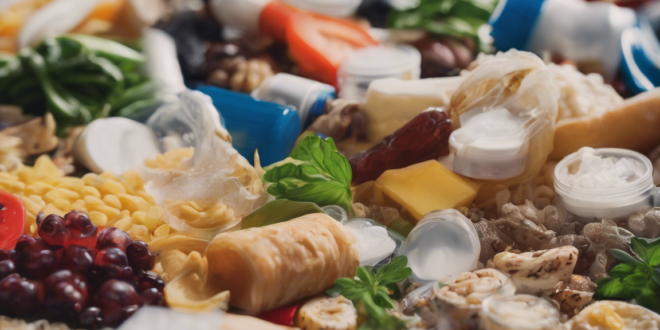10 Common Foods Contaminated with Microplastics: A Comprehensive Guide to Reducing Your Exposure
In the modern world, microplastics have become an increasingly prevalent environmental concern, silently infiltrating our food supply and raising significant health questions. These microscopic plastic particles, typically less than 5 millimeters in size, are now found in almost every aspect of our daily lives, including the food we consume. This comprehensive guide will explore the most common foods contaminated with microplastics and provide practical strategies to minimize your exposure.
Understanding Microplastics: What Are They and Why Should You Care?
Microplastics are tiny plastic fragments that result from the breakdown of larger plastic materials or are intentionally manufactured for various industrial purposes. These minuscule particles have become a global environmental crisis, permeating ecosystems from the deepest ocean trenches to the most remote mountain ranges. Recent scientific studies have detected microplastics in human blood, placenta, and even lung tissue, highlighting the urgent need to understand and mitigate their potential health impacts.
Top 10 Foods Most Likely to Contain Microplastics
1. Seafood and Fish
Marine environments are particularly vulnerable to plastic contamination, making seafood one of the most significant sources of microplastic exposure. Fish and shellfish absorb these particles directly from polluted water, with studies showing that popular seafood like tuna, salmon, and sardines can contain substantial amounts of microplastics. Larger predatory fish tend to accumulate more microplastics through a process called biomagnification.
2. Bottled Water
Ironically, the very containers designed to provide clean drinking water are themselves a major source of microplastic contamination. Plastic water bottles shed microscopic particles during production, transportation, and storage. Research indicates that a single plastic water bottle can release hundreds of thousands of microplastic particles, significantly increasing your daily exposure.
3. Salt
Both sea salt and rock salt have been found to contain varying levels of microplastics. Marine salt, in particular, demonstrates higher contamination rates due to widespread ocean pollution. A global study revealed that approximately 90% of table salt brands worldwide contain microplastic particles, emphasizing the pervasive nature of this environmental issue.
4. Processed Foods
Packaged and processed foods are particularly susceptible to microplastic contamination. Plastic packaging, food processing equipment, and transportation containers can all contribute to microplastic migration into food products. Processed meats, frozen meals, and ready-to-eat snacks are especially vulnerable to this type of contamination.
5. Fruits and Vegetables
Even seemingly “clean” produce is not immune to microplastic contamination. Agricultural practices involving plastic mulch, irrigation with contaminated water, and plastic-based pesticide applications can introduce microplastics into soil and plant tissues. Root vegetables like carrots and potatoes are particularly prone to absorbing these particles.
6. Beer and Alcoholic Beverages
Surprisingly, alcoholic beverages, including beer and spirits, have been found to contain measurable amounts of microplastics. The brewing and bottling processes, along with ingredient sourcing, can contribute to microplastic presence in these popular drinks.
7. Tea Bags
Many modern tea bags are constructed using plastic-based materials that can release microplastics when exposed to hot water. Even paper tea bags often contain plastic sealants that break down during brewing, potentially contaminating your favorite beverage.
8. Honey
Global studies have detected microplastics in honey samples from various regions, indicating that bees can inadvertently collect and transport these particles during nectar collection. The environmental contamination of flowering plants contributes to this unexpected source of microplastic exposure.
9. Canned Foods
The internal linings of food cans, typically made from plastic-based materials, can leach microplastics into the contents. Canned vegetables, fruits, and prepared meals may contain higher concentrations of these particles compared to fresh alternatives.
10. Dairy Products
Milk and dairy products can accumulate microplastics through multiple channels, including plastic packaging, animal feed contamination, and environmental exposure. Plastic milk jugs and processing equipment further contribute to potential microplastic presence.
Strategies to Reduce Microplastic Exposure
1. Choose Alternative Packaging
Opt for glass, stainless steel, or ceramic containers instead of plastic. These materials are less likely to shed microplastic particles and provide a safer storage solution for food and beverages.
2. Filter Your Water
Invest in high-quality water filtration systems designed to remove microplastics. Reverse osmosis and activated carbon filters can significantly reduce your exposure to these particles.
3. Minimize Processed Foods
Prioritize fresh, whole foods and reduce consumption of heavily processed and packaged items. This approach not only decreases microplastic intake but also promotes overall nutritional health.
4. Use Natural Fiber Cooking Tools
Replace plastic cooking utensils with wooden, bamboo, or stainless steel alternatives. These materials are less likely to shed microplastic particles during food preparation.
5. Support Environmental Initiatives
Participate in local and global efforts to reduce plastic pollution. Supporting legislation, participating in cleanup initiatives, and raising awareness can contribute to long-term environmental solutions.
Conclusion: A Proactive Approach to Microplastic Reduction
While completely eliminating microplastic exposure may be challenging, informed consumers can significantly reduce their risk through conscious choices and lifestyle modifications. By understanding the sources of microplastic contamination and implementing strategic alternatives, individuals can protect their health and contribute to broader environmental sustainability efforts.
As research continues to unveil the potential long-term impacts of microplastic exposure, staying informed and adaptable remains crucial. Prioritize your health, make mindful consumption choices, and support initiatives working towards a cleaner, plastic-free future.
 Good Calories Guide GoodCalories Guide focuses on nutrition, healthy eating, and overall wellness. The site offers practical insights into evidence-based dietary practices, including tips for specific lifestyles such as veganism, keto, and family-friendly meal planning. It also addresses unique nutritional needs for individuals with conditions like diabetes or food allergies, while providing quick and accessible recipes to make healthy living a sustainable and enjoyable choice.
Good Calories Guide GoodCalories Guide focuses on nutrition, healthy eating, and overall wellness. The site offers practical insights into evidence-based dietary practices, including tips for specific lifestyles such as veganism, keto, and family-friendly meal planning. It also addresses unique nutritional needs for individuals with conditions like diabetes or food allergies, while providing quick and accessible recipes to make healthy living a sustainable and enjoyable choice.


